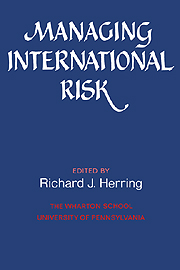 Managing International Risk
Managing International Risk Published online by Cambridge University Press: 07 May 2010
Introduction
From a U.S. or West European perspective investment in the Second and Third Worlds looks very much riskier than investment at home. Recent events in Poland and Mexico, among other places, seem to provide dramatic confirmation that this perception is well founded. There is a lot to worry about: The increased internationalization of investment in the last decade has enormously raised the exposure of investors to risks associated with events in many different countries.
As a consequence of this situation, institutional investors and public organizations concerned with international investment are devoting substantial resources to analyzing the risks of investment abroad. There have been significant improvements in the collection and dissemination of data on foreign investment. Some investors have developed statistical models that attempt to evaluate the safety of loans to particular countries.
We believe, however, that this activity is unfortunately taking place without an adequately articulated conceptual framework that identifies the fundamental sources of country risk. This analysis is unlikely to be very robust if it is not based on appropriate theoretical notions. Without a good specification of what motivates borrowers and lenders it is difficult to identify which data are important for analyzing country risk. In addition, there is no reason to believe that apparent regularities derived from past data using econometric models will continue in the future unless these models are specified using an appropriate theory.
To save this book to your Kindle, first ensure [email protected] is added to your Approved Personal Document E-mail List under your Personal Document Settings on the Manage Your Content and Devices page of your Amazon account. Then enter the ‘name’ part of your Kindle email address below. Find out more about saving to your Kindle.
Note you can select to save to either the @free.kindle.com or @kindle.com variations. ‘@free.kindle.com’ emails are free but can only be saved to your device when it is connected to wi-fi. ‘@kindle.com’ emails can be delivered even when you are not connected to wi-fi, but note that service fees apply.
Find out more about the Kindle Personal Document Service.
To save content items to your account, please confirm that you agree to abide by our usage policies. If this is the first time you use this feature, you will be asked to authorise Cambridge Core to connect with your account. Find out more about saving content to Dropbox.
To save content items to your account, please confirm that you agree to abide by our usage policies. If this is the first time you use this feature, you will be asked to authorise Cambridge Core to connect with your account. Find out more about saving content to Google Drive.